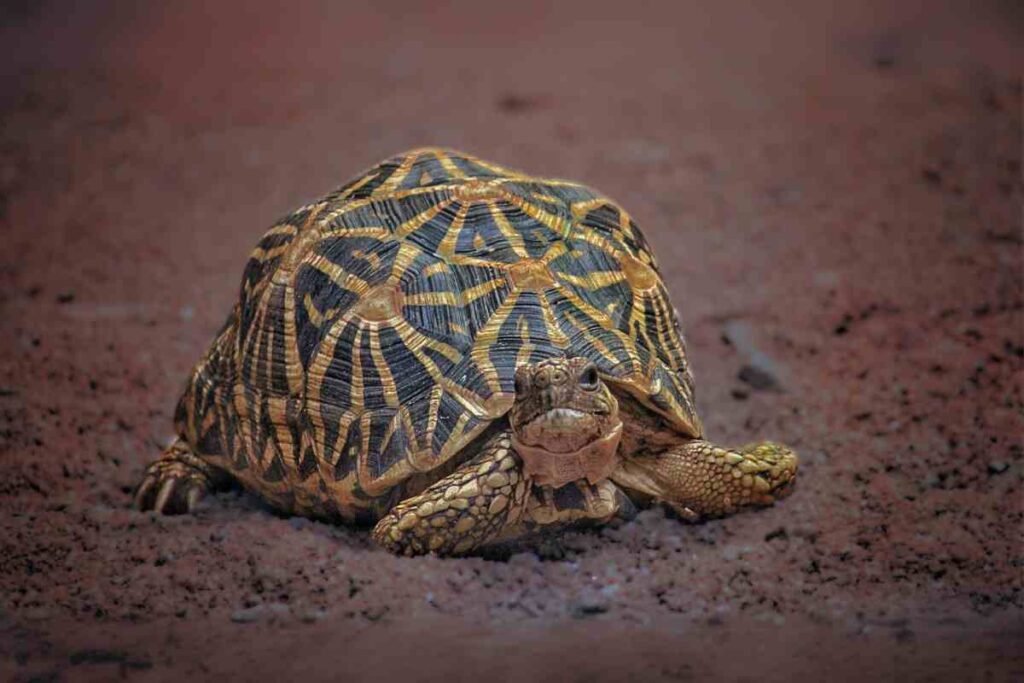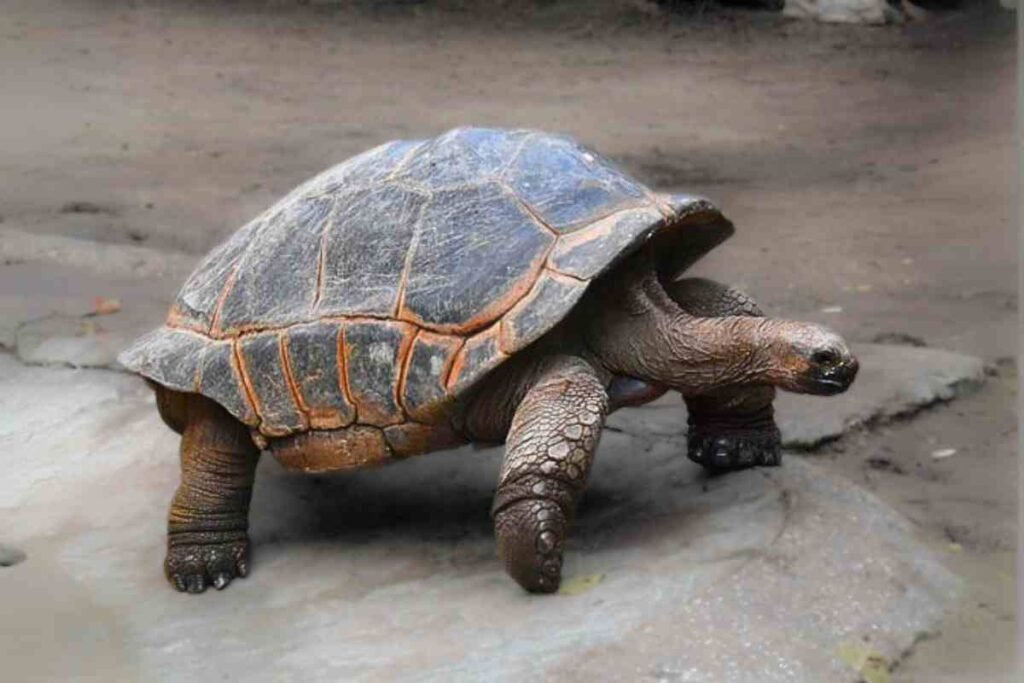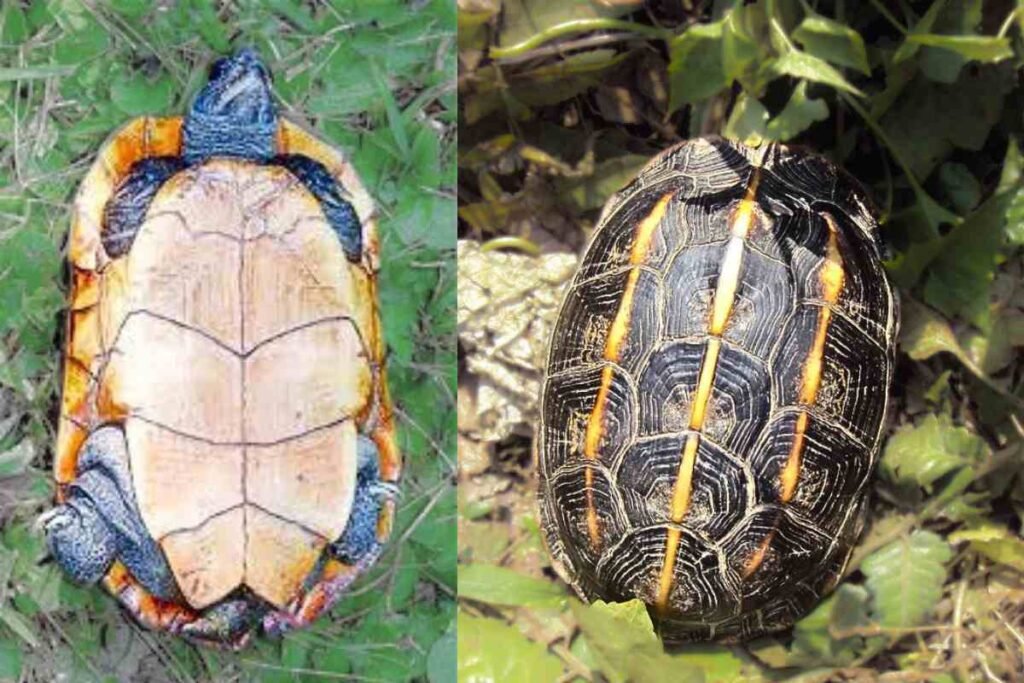India is home to a diverse range of reptiles, and types of tortoises in india are amoung the most facinating. India boasts an incredible variety of these ancient creatures.
Unfortunately, many of these species face significant threats from habitat loss, poaching, and climate change.
Understanding the different types of tortoise in India, their unique features, and their conservation status is vital in appreciating the country’s rich biodiversity and the need for their protection.
In this article, we explore the ten most fascinating types of tortoises in India, some of which are on the brink of extinction.
Indian Star Tortoise (Geochelone elegans)

One of the most iconic types of tortoise in India, the Indian Star Tortoise is known for its striking star-patterned shell. Found in dry scrub forests and semi-arid regions across the Indian subcontinent, this species has earned a reputation as a pet in the exotic pet trade. However, its popularity has led to overexploitation, threatening its numbers in the wild.
- Max Shell Length: Up to 30 cm
- Habitat: Dry grasslands, scrub forests
- Conservation Status: Endangered (IUCN Red List)
The Indian Star Tortoise is a herbivore and feeds on grasses, herbs, and fruits. Its beautifully patterned shell helps it blend into its natural surroundings, making it an effective defense mechanism against predators.
Travancore Tortoise (Indotestudo travancorica)
Native to the Western Ghats of India, the Travancore Tortoise is one of the largest types of tortoise in India. It is mostly found in forested areas at elevations between 450 and 850 meters. This species primarily feeds on grasses, herbs, and occasionally insects.
- Max Shell Length: 33 cm
- Habitat: Hill forests of Kerala, Karnataka, and Tamil Nadu
- Conservation Status: Vulnerable (IUCN Red List)
The Travancore Tortoise is also threatened by habitat destruction due to deforestation and forest fires. Conservation efforts are ongoing, but the species remains at risk.
Leopard Tortoise (Stigmochelys pardalis)
While native to Africa, the Leopard Tortoise has been spotted in India, particularly in pet trades. This tortoise, one of the types of tortoise in India, is easily recognizable by its large size and leopard-like shell markings. It thrives in both semi-desert and forest environments.
- Max Shell Length: Up to 60 cm
- Habitat: Grasslands, open woodlands
- Conservation Status: Near Threatened (IUCN Red List)
The Leopard Tortoise is primarily herbivorous and has a strong, domed shell that helps protect it from predators.
Aldabra Giant Tortoise (Aldabrachelys gigantea)

The Aldabra Giant Tortoise is one of the largest types of tortoise in India. While native to the Aldabra Atoll in the Indian Ocean, it has been introduced to some parts of India for conservation purposes. This tortoise is known for its impressive size and longevity.
- Max Shell Length: Up to 120 cm
- Habitat: Coastal areas, island ecosystems
- Conservation Status: Vulnerable (IUCN Red List)
This species is herbivorous, feeding mainly on grasses, leaves, and fruits. Their slow movement and large size make them a majestic species in the wild.
Russian Tortoise (Testudo horsfieldii)
The Russian Tortoise, although native to Central Asia, is often found in India due to the pet trade. This small species is among the types of tortoise in India that has adapted well to dry, semi-arid environments.
- Max Shell Length: 20 cm
- Habitat: Grasslands, deserts
- Conservation Status: Vulnerable (IUCN Red List)
This tortoise is an omnivore and feeds on a mix of vegetation and small insects. It has a reputation for being hardy and can survive in harsher conditions compared to other species.
Indian Roofed Turtle (Pangshura tecta)
Found in the rivers and lakes of South Asia, the Indian Roofed Turtle is another notable type of tortoise in India. It is easily identified by the characteristic ridge on its shell. This freshwater species is commonly found in slow-moving rivers and ponds.
- Max Shell Length: 22 cm
- Habitat: Freshwater rivers, ponds, canals
- Conservation Status: Endangered (IUCN Red List)
The Indian Roofed Turtle is a peaceful species that spends much of its time basking in the sun or hiding under the water to avoid predators.
Red-Crowned Roofed Turtle (Kachuga kachuga)
This species is found in the large rivers of northern India, especially the Chambal River. The Red-Crowned Roofed Turtle is one of the most endangered types of tortoise in India, with males developing a brilliant courtship coloration of red, yellow, and blue at the end of the rainy season.
- Max Shell Length: 56 cm
- Habitat: Rivers and freshwater bodies
- Conservation Status: Critically Endangered (IUCN Red List)
This turtle’s populations have dwindled significantly due to habitat loss, poaching, and pollution, making it a key species for conservation efforts in India.
Ganges Softshell Turtle (Aspideretes gangeticus)
The Ganges Softshell Turtle is native to the major rivers of India, including the Ganges, Indus, and Mahanadi rivers. Known for its leathery shell, this species is often found in sandy riverbeds.
- Max Shell Length: 75 cm
- Habitat: Freshwater rivers
- Conservation Status: Vulnerable (IUCN Red List)
This species faces threats from overfishing, pollution, and habitat destruction. Conservation initiatives are focusing on protecting their natural habitats.
Indian Peacock Softshell Turtle (Aspideretes hurum)
Native to India and Bangladesh, the Indian Peacock Softshell Turtle is a large species found in rivers like the Brahmaputra and Ganges. Known for its unique, flattened softshell, this species is highly endangered.
- Max Shell Length: 80 cm
- Habitat: Rivers with sandy or muddy bottoms
- Conservation Status: Endangered (IUCN Red List)
The Indian Peacock Softshell Turtle faces a growing threat from illegal wildlife trade and pollution. Conservation efforts aim to curb poaching and protect their habitats.
Three-Keeled Land Tortoise (Melanochelys tricarinata)

This species is native to northeastern India, particularly in the Ganges and Brahmaputra drainages. Recognized by the three distinct keels on its shell, this tortoise prefers dry and semi-arid environments.
- Max Shell Length: 15 cm
- Habitat: Deciduous forests and grasslands
- Conservation Status: Endangered (IUCN Red List)
The Three-Keeled Land Tortoise faces the dual threat of habitat loss and illegal poaching for the pet trade.
Conclusion
India’s tortoises are not only remarkable for their unique characteristics and survival strategies, but they also face numerous threats in the modern world.
From habitat loss to poaching, many of these types of tortoise in india are at risk of extinction. It is essential for conservation efforts to continue to ensure that these ancient reptiles thrive in their natural environments for generations to come.
FAQs
What habitats do tortoises in India prefer?
Most Indian tortoises inhabit dry forests, grasslands, and freshwater areas depending on the species.
How do tortoises in India protect themselves from predators?
Many species use their shells’ patterns and colors as camouflage to blend into their surroundings.
Are tortoises in India important for the ecosystem?
Yes, they help control vegetation and serve as prey for other wildlife, maintaining ecological balance.
Can tortoises in India be kept as pets legally?
Some species are protected by law and cannot be kept as pets; always check local regulations before acquiring one.
What threats are common to tortoises across India?
Habitat destruction, illegal poaching, and pollution are major threats impacting many Indian tortoise species.